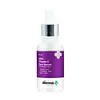What's inside
What's inside
 Key Ingredients
Key Ingredients

 Benefits
Benefits

 Ingredients Side-by-side
Ingredients Side-by-side

Water
Skin Conditioning3-O-Ethyl Ascorbic Acid
Skin ConditioningEthoxydiglycol
HumectantButylene Glycol
HumectantFerulic Acid
AntimicrobialHyaluronic Acid
HumectantDipotassium Glycyrrhizate
HumectantTrisodium Ethylenediamine Disuccinate
Hydroxyethylcellulose
Emulsion StabilisingSuccinoglycan
Skin ConditioningSodium Polyacrylate
AbsorbentCitric Acid
BufferingSodium Citrate
BufferingSodium Benzoate
MaskingPotassium Metabisulfite
PreservativeHippophae Rhamnoides Fruit Extract
Skin ConditioningGlycerin
HumectantButylene Glycol
HumectantNiacinamide
SmoothingCaprylic/Capric Triglyceride
Masking1,2-Hexanediol
Skin ConditioningBetaine
HumectantLimnanthes Alba Seed Oil
Skin ConditioningGlyceryl Stearate
EmollientPropanediol
SolventWater
Skin ConditioningGlycereth-26
HumectantCetearyl Olivate
Carbomer
Emulsion StabilisingSorbitan Olivate
EmulsifyingTromethamine
BufferingCoptis Japonica Root Extract
Skin ConditioningSodium Polyacryloyldimethyl Taurate
Emulsion StabilisingHydrogenated Polydecene
EmollientEthylhexylglycerin
Skin ConditioningDisodium EDTA
Biosaccharide Gum-1
HumectantMelia Azadirachta Flower Extract
Skin ConditioningOcimum Sanctum Leaf Extract
Skin ConditioningHippophae Rhamnoides Oil
EmollientMelia Azadirachta Leaf Extract
Skin ConditioningPanthenol
Skin ConditioningTheobroma Cacao Seed Extract
AntioxidantTrideceth-10
CleansingAmmonium Polyacryloyldimethyl Taurate
Emulsion StabilisingHyaluronic Acid
HumectantHydrolyzed Hyaluronic Acid
HumectantSodium Hyaluronate
HumectantCurcuma Longa Root Extract
MaskingCorallina Officinalis Extract
Skin Conditioning3-O-Ethyl Ascorbic Acid
Skin ConditioningDextrin
AbsorbentHydroxyethylcellulose
Emulsion StabilisingAscorbyl Glucoside
AntioxidantHippophae Rhamnoides Fruit Extract, Glycerin, Butylene Glycol, Niacinamide, Caprylic/Capric Triglyceride, 1,2-Hexanediol, Betaine, Limnanthes Alba Seed Oil, Glyceryl Stearate, Propanediol, Water, Glycereth-26, Cetearyl Olivate, Carbomer, Sorbitan Olivate, Tromethamine, Coptis Japonica Root Extract, Sodium Polyacryloyldimethyl Taurate, Hydrogenated Polydecene, Ethylhexylglycerin, Disodium EDTA, Biosaccharide Gum-1, Melia Azadirachta Flower Extract, Ocimum Sanctum Leaf Extract, Hippophae Rhamnoides Oil, Melia Azadirachta Leaf Extract, Panthenol, Theobroma Cacao Seed Extract, Trideceth-10, Ammonium Polyacryloyldimethyl Taurate, Hyaluronic Acid, Hydrolyzed Hyaluronic Acid, Sodium Hyaluronate, Curcuma Longa Root Extract, Corallina Officinalis Extract, 3-O-Ethyl Ascorbic Acid, Dextrin, Hydroxyethylcellulose, Ascorbyl Glucoside
 Reviews
Reviews

Ingredients Explained
These ingredients are found in both products.
Ingredients higher up in an ingredient list are typically present in a larger amount.
You might know this ingredient as Ethyl Ascorbic Acid, a more stable version of ascorbic acid.
Like other types of vitamin C, this ingredient has many benefits including reducing wrinkles, skin soothing, dark spot fading, and fighting against free radicals.
3-O-Ethyl Ascorbic Acid interferes with the process of skin darkening, helping to reduce hyperpigmentation. It also encourages the skin to produce more collagen.
Once applied, 3-O-Ethyl Ascorbic Acid is converted to Vitamin C deeper in the skin's layers. This process is slow but makes this ingredient more tolerable for skin.
The optimum pH range for this ingredient is 4 - 5.5
Learn more about 3-O-Ethyl Ascorbic AcidButylene Glycol (or BG) is used within cosmetic products for a few different reasons:
Overall, Butylene Glycol is a safe and well-rounded ingredient that works well with other ingredients.
Though this ingredient works well with most skin types, some people with sensitive skin may experience a reaction such as allergic rashes, closed comedones, or itchiness.
Learn more about Butylene GlycolHyaluronic acid is naturally found in healthy skin. It is a humectant, meaning it draws moisture to your skin.
This ingredient helps hydrate, soothe, and protect the skin.
What makes hyaluronic acid so hydrating? It has the capacity to bind or hold large amounts of water.
Fun fact: It is already naturally found in our bodies, such as the fluids of our eyes and our joints.
Studies find this ingredient to have anti-inflammatory and anti-microbial properties. This can help speed up wound-healing.
Hyaluronic acid can be irritating if the molecule has a low-molecular weight, or if the molecules are small.
One study found low-molecular weight hyaluronic acid to be pro-inflammatory, meaning some people may experience irritation. This is because our bodies use hyaluronic acid in the wound-healing process to signal to our bodies, via irritation, that something needs healing.
The same study found high-molecular weight hyaluronic acid to be anti-inflammatory.
These are some other common types of Hyaluronic Acid:
Learn more about Hyaluronic AcidHydroxyethylcellulose is used to improve the texture of products. It is created from a chemical reaction involving ethylene oxide and alkali-cellulose. Cellulose is a sugar found in plant cell walls and help give plants structure.
This ingredient helps stabilize products by preventing ingredients from separating. It can also help thicken the texture of a product.
This ingredient can also be found in pill medicines to help our bodies digest other ingredients.
Learn more about HydroxyethylcelluloseWater. It's the most common cosmetic ingredient of all. You'll usually see it at the top of ingredient lists, meaning that it makes up the largest part of the product.
So why is it so popular? Water most often acts as a solvent - this means that it helps dissolve other ingredients into the formulation.
You'll also recognize water as that liquid we all need to stay alive. If you see this, drink a glass of water. Stay hydrated!
Learn more about Water